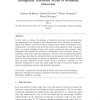325 search results - page 5 / 65 » Evolvable network architectures: what can we learn from biol... |
ITS
2010
Springer
14 years 6 days ago
2010
Springer
The traditional, well established approach to finding out what works in education research is to run a randomized controlled trial (RCT) using a standard pretest and posttest desig...
TSMC
2010
13 years 2 months ago
2010
There exists a widely recognized need to better understand and manage complex "systems of systems," ranging from biology, ecology, and medicine to network-centric technol...
ICES
1998
Springer
13 years 11 months ago
1998
Springer
In this paper we present a new chromosome representation for evolving digital circuits. The representation is based very closely on the chip architecture of the Xilinx 6216 FPGA. W...
CN
2010
13 years 7 months ago
2010
The natural world is enormous, dynamic, incredibly diverse, and highly complex. Despite the inherent challenges of surviving in such a world, biological organisms evolve, self-org...
IJON
2008
13 years 7 months ago
2008
In this work we address the problem of boundary detection by combining ideas and approaches from biological and computational vision. Initially, we propose a simple and efficient ...

